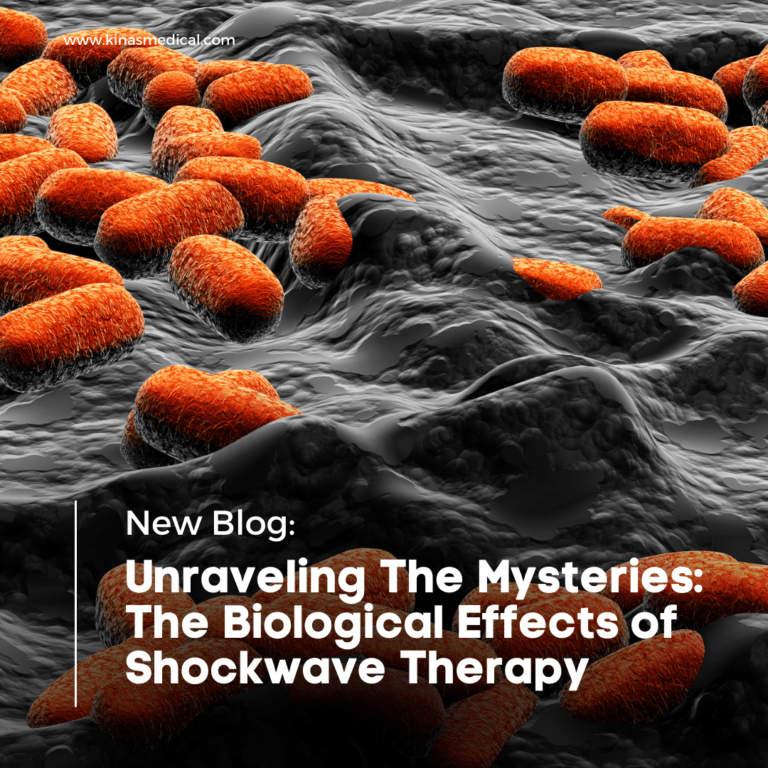Author: Brett Brodbeck, DC, CFMP
Outline:
- Introduction
- Mechanotransduction
- Gene Expression
- Enzymatic Tissue Response
- Macroscopic Healing
- Hyperstimulation Analgesia
- Conclusion
- Future Directions
Introduction
Shockwave therapy is an intriguing and promising treatment for a wide range of musculoskeletal disorders. But what makes it work? What’s going on under the surface when those waves hit our tissues? Though the biological mechanisms underlying shockwave therapy are still partly shrouded in mystery, we’ve made some significant strides in understanding. Today, we’ll journey through the fascinating world of the biological effects of shockwave therapy, exploring mechanotransduction, gene expression, enzymatic tissue response, visible healing, and hyperstimulation analgesia.
Mechanotransduction: The Cellular Powerhouse
Think of mechanotransduction as the cell’s own unique interpretation of a dance. It’s the process by which cells take the mechanical energy from shockwave therapy and convert it into cellular responses. This mechanical energy shakes up the cytoskeleton and the extracellular molecules connected to it, creating a ripple effect in cellular structures, including the cell nucleus, endoplasmic reticulum, and mitochondria. It’s a complex process, and we’re still uncovering the specific ways different cells respond and the signaling pathways activated.
Gene Expression: The Cellular Language of Healing
Imagine the cell nucleus receiving a call to action via the excited cytoskeleton. This call can lead to gene expression, which is akin to the cell using its unique genetic language to produce proteins and other molecules. Research on the biological effects of shockwave suggests that extracorporeal shock wave therapy (ESWT) can boost the release of m-RNA for specific growth factors, such as VEGF, a VIP in the formation of new blood vessels. However, the specific genes activated can be a bit choosy, depending on factors like tissue type and shockwave intensity.
Enzymatic Tissue Response: A Complex Cascade
The biological impact of shockwave therapy doesn’t end there. It can also trigger an enzymatic tissue response, setting off a fascinating domino effect of changes in various substances. Animal studies have shown that ESWT can shake up levels of several substances, including nitric oxide (NO), prostaglandin E2, and COX-2, among others. However, it’s worth noting that these changes aren’t set in stone for all treatments—they can vary depending on the specifics of the shockwave therapy.
Macroscopically Recognizable Healing: The Long Road to Recovery
Healing isn’t an overnight process—it’s more of a marathon than a sprint. It can take months to see visible changes in tissue. One exciting part of this journey is neovascularization—the formation of new blood vessels—a process thought to play a central role in the healing process following ESWT treatment. Alongside this, changes in nerve cells, potentially leading to pain reduction, have also been observed after shockwave therapy. However, this refers to observable changes in tissue structure or function, like improvements in mobility or reductions in pain.
Hyperstimulation Analgesia: A Puzzling Piece of Pain Relief
Our understanding of the pain-relief effects of shockwave therapy has evolved over time. We first thought it might be due to the gate-control mechanism, a theory suggesting that repeated nerve irritation could change pain processing in the spinal cord. However, recent research suggests that molecular biological changes might be the key players, although the interaction between these changes and our nervous system’s response to pain is likely a complex dance that we’re still learning.
Conclusion
The biological effects of shockwave therapy are like an intricate puzzle, with pieces we’re still trying to understand. The picture we’re piecing together suggests that mechanotransduction, gene expression, enzymatic tissue response, and visible healing are crucial to the therapeutic effects of this treatment modality. But as with any puzzle, new pieces may come to light as our understanding grows and evolves.
Future Directions: The Exciting Frontier of Shockwave Therapy
As we continue to probe the intricacies of shockwave therapy, we might uncover new insights that could enhance the treatment’s effectiveness or widen its application. For instance, how do we fine-tune the frequency or intensity of shockwaves for different tissue types or conditions? Could we predict a patient’s response to therapy based on their genetic makeup? Could shockwave therapy help the effectiveness of specific medications? These are the tantalizing questions that future research in this field could help to answer.
So, the next time you encounter shockwave therapy, remember: It’s not just a series of waves. It’s a sophisticated treatment that harnesses the power of biology and physics to help our bodies heal. And as we continue to delve deeper into this fascinating field, who knows what exciting discoveries lie ahead.
Stay tuned to our blog for more on the latest in shockwave therapy research and developments. Together, we’ll continue exploring the fascinating ways that science helps us understand our bodies and improve our health.

